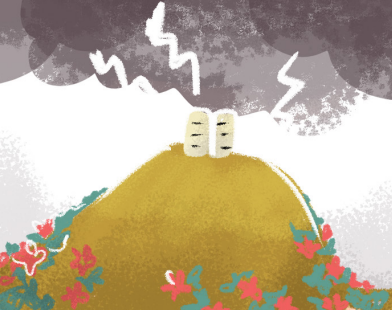Ilustration Credit: Rivka Tsinman

Tell Me More About This! בּוֹאוּ נְדַבֵּר עַל זֶה
What is Tu Bishvat? “Tu” stands for ט”ו, which has the numerical value of 15. So Tu Bishvat is the 15th day of Shevat.
According to the Mishnah, there are four dates during the year that are each called “Rosh Hashanah” (New Year) for different reasons, and Tu Bishvat is one of them.
אַרְבָּעָה רָאשֵׁי שָׁנִים הֵם.
(1) בְּאֶחָד בְּנִיסָן רֹאשׁ הַשָּׁנָה לַמְּלָכִים וְלָרְגָלִים.
(2) בְּאֶחָד בֶּאֱלוּל רֹאשׁ הַשָּׁנָה לְמַעְשַׂר בְּהֵמָה…
(3) בְּאֶחָד בְּתִשְׁרֵי רֹאשׁ הַשָּׁנָה לַשָּׁנִים וְלַשְּׁמִטִּין וְלַיּוֹבְלוֹת, לַנְּטִיעָה וְלַיְרָקוֹת.
(4) בְּאֶחָד בִּשְׁבָט רֹאשׁ הַשָּׁנָה לָאִילָן, כְּדִבְרֵי בֵית שַׁמַּאי. בֵּית הִלֵּל אוֹמְרִים, בַּחֲמִשָּׁה עָשָׂר בּוֹ:
There are four Rosh Hashanahs:
The 1st day of Nisan is Rosh Hashanah for counting the years of a king’s reign and knowing when the new season of holidays starts.
The 1st day of Elul is Rosh Hashanah for grouping newborn animals together in order to give one tenth to the kohanim…
The 1st day of Tishrei is Rosh Hashanah for the Jewish calendar, knowing when the shemittah and yovel years start, counting the first three years of a new plant (when its fruits are forbidden), and grouping vegetable harvests together in order to give portions to kohanim, Levi’im, and people who are poor.
The 1st day of Shevat is Rosh Hashanah for the tree—according to Beit Shammai. Beit Hillel say: the 15th day of Shevat.
This mishnah explains that we mark the ages of different things on different dates. Tu Bishvat is the date when we mark the age of fruit that grows on trees – that’s what makes it a Rosh Hashanah for trees.
Why do we need to know the age of fruit? You can look at the halakhah section for all the details! One reason we discuss there is that fruit growing on a tree three years old or younger is called עָרְלָה (orlah) and isn’t allowed to be eaten. Tu Bishvat is the cutoff date for calculating when fruit is considered orlah. Another reason is that people need to give a percentage of their fruit as תְּרוּמָה (terumah) and מַעֲשֵׂר (ma’aser). These are gifts for kohanim, Levi’im, and poor people. Tu Bishvat is the cut-off date for calculating how much of these to give each year.
-------------------
-------------------





